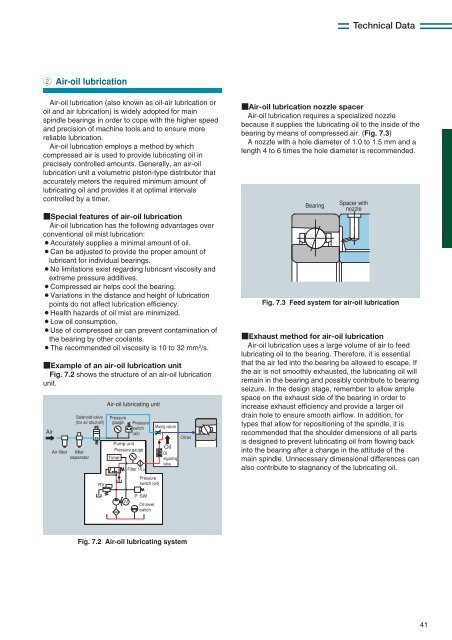NTN - Precision Rolling Bearings
Create successful ePaper yourself
Turn your PDF publications into a flip-book with our unique Google optimized e-Paper software.
Technical Data<br />
2 Air-oil lubrication<br />
Air-oil lubrication (also known as oil-air lubrication or<br />
oil and air lubrication) is widely adopted for main<br />
spindle bearings in order to cope with the higher speed<br />
and precision of machine tools and to ensure more<br />
reliable lubrication.<br />
Air-oil lubrication employs a method by which<br />
compressed air is used to provide lubricating oil in<br />
precisely controlled amounts. Generally, an air-oil<br />
lubrication unit a volumetric piston-type distributor that<br />
accurately meters the required minimum amount of<br />
lubricating oil and provides it at optimal intervals<br />
controlled by a timer.<br />
Special features of air-oil lubrication<br />
Air-oil lubrication has the following advantages over<br />
conventional oil mist lubrication:<br />
¡Accurately supplies a minimal amount of oil.<br />
¡Can be adjusted to provide the proper amount of<br />
lubricant for individual bearings.<br />
¡No limitations exist regarding lubricant viscosity and<br />
extreme pressure additives.<br />
¡Compressed air helps cool the bearing.<br />
¡Variations in the distance and height of lubrication<br />
points do not affect lubrication efficiency.<br />
¡Health hazards of oil mist are minimized.<br />
¡Low oil consumption.<br />
¡Use of compressed air can prevent contamination of<br />
the bearing by other coolants.<br />
¡The recommended oil viscosity is 10 to 32 mm 2 /s.<br />
Example of an air-oil lubrication unit<br />
Fig. 7.2 shows the structure of an air-oil lubrication<br />
unit.<br />
Air<br />
Air filter<br />
Solenoid valve<br />
(for air shut-off)<br />
Mist<br />
separator<br />
RV<br />
Air-oil lubricating unit<br />
Pressure<br />
gauge<br />
Pump unit<br />
Timer<br />
Pressure<br />
switch<br />
(air)<br />
Pressure gauge<br />
Filter 10<br />
Pressure<br />
switch (oil)<br />
Mixing valuve<br />
Oil/air<br />
Oil<br />
Oil<br />
regulating<br />
valve<br />
Air-oil lubrication nozzle spacer<br />
Air-oil lubrication requires a specialized nozzle<br />
because it supplies the lubricating oil to the inside of the<br />
bearing by means of compressed air. (Fig. 7.3)<br />
A nozzle with a hole diameter of 1.0 to 1.5 mm and a<br />
length 4 to 6 times the hole diameter is recommended.<br />
Bearing<br />
Spacer with<br />
nozzle<br />
Fig. 7.3 Feed system for air-oil lubrication<br />
Exhaust method for air-oil lubrication<br />
Air-oil lubrication uses a large volume of air to feed<br />
lubricating oil to the bearing. Therefore, it is essential<br />
that the air fed into the bearing be allowed to escape. If<br />
the air is not smoothly exhausted, the lubricating oil will<br />
remain in the bearing and possibly contribute to bearing<br />
seizure. In the design stage, remember to allow ample<br />
space on the exhaust side of the bearing in order to<br />
increase exhaust efficiency and provide a larger oil<br />
drain hole to ensure smooth airflow. In addition, for<br />
types that allow for repositioning of the spindle, it is<br />
recommended that the shoulder dimensions of all parts<br />
is designed to prevent lubricating oil from flowing back<br />
into the bearing after a change in the attitude of the<br />
main spindle. Unnecessary dimensional differences can<br />
also contribute to stagnancy of the lubricating oil.<br />
<br />
PSW<br />
Oil level<br />
switch<br />
Fig. 7.2 Air-oil lubricating system<br />
41

















